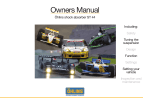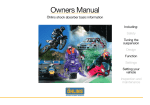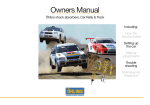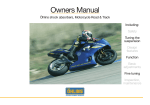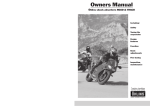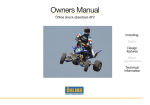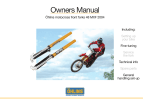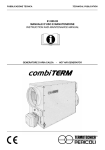Download Owners Manual
Transcript
Owners Manual Öhlins shock absorber, Car Road & Track Including: Safety Tuning the suspension Design Function Settings Setting your vehicle Inspection and maintenance 1 Safety signals Important information concerning safety is distinguished in this manual by the following notations: The Safety alert symbol means: Caution! Your safety is involved. WARNING! Failure to follow warning instructions could result in severe or fatal injury to anyone working with, inspecting or using the suspension, or to bystanders. CAUTION! Caution indicates that special precautions must be taken to avoid damage to the suspension. NOTE! This indicates information that is of importance with regard to procedures. Introduction All of Öhlins advanced suspension products are adepted to the brand and model. This means that length, travel springaction and damping characteristics, are tested individually just for the vehicle that you have decided to fit with Öhlins suspension. WARNING! The specifications for the particular suspension/ shock absorber are developed in tests on a factory equipped vehicle. If wheel dimensions, springs and/or other chassis parts have been changed or modified, the clearances and the stability of the vehicle can be affected. Before installation Öhlins Racing AB can not be held responsible for any damage whatsoever to suspension or vehicle, or injury to persons, if the instructions for fitting and maintenance are not followed exactly. Similarly, the warranty will become null and void if the instructions are not adhered to. Contents © Öhlins Racing AB. All rights reserved. Any reprinting or unauthorized use without the written permission of Öhlins Racing AB is prohibited. 2 Safety ............................................................. 2 Tuning the suspension .................................... 3 Design ............................................................ 3 Function ......................................................... 4 Settings .......................................................... 4 Setting your vehicle ........................................ 6 Inspection and maintenance .......................... 7 WARNING! 1. Installing a suspension, that is not approved by the vehicle manufacturer, may affect the stability of your vehicle. Öhlins Racing AB cannot be held responsible for any personal injury or damage whatsoever that may occur after fitting the suspension. Contact an Öhlins dealer or other qualified person for advice. 2. Please study and make certain that you fully understand all the mounting instructions and the owners manuals before handling this suspension kit. If you have any questions regarding proper installation procedures, contact an Öhlins dealer or other qualified person. 3. The vehicle service manual must be referred to when installing the Öhlins suspension. NOTE Öhlins products are subject to continual improvement and development. Consequently, although these instructions include the most up-to-date information available at the time of printing, there may be minor differences between your suspension and this manual. Please consult your Öhlins dealer if you have any questions regarding the contents of the manual. Design principles Gas Base plate (restrictor) Fluid Gas Fluid Dividing piston Dividing piston Shock absorber piston 1. 2. 3. 4. Fig.1: External reservoir with hose connection Fig.2: External piggyback reservoir Fig.3: Internal gas reservoir Fig.4: Internal reservoir with base plate Tuning the suspension Design Road holding qualities All vehicles are designed with a suspension geometry that includes wheel movements and angles. The changing of components can affect this and it is therefore essential that both the rear and the front ends match each other. Changing to Öhlins suspension gives optimum performance only when both the front and the rear suspension interact properly. Most Öhlins suspensions are of the high pressure mono tube type. The fluid is put under gas pressure. The gas and the fluid are kept apart by a separating piston. The separating piston is fitted inside the main shock absorber (internal gas reservoir) (1) or in a separate fluid reservoir, connected by hose (2) or fixed direct on top of the shock absorber (piggyback) (3). A few shock absorbers have a larger diameter separating piston combined with a base plate (4) Pressurization of the fluid is made with nitrogen. The pressurization prevents cavitation of the fluid and the shock absorbing action is therefore more even. The external fluid chambers also contribute to better cooling of the fluid, giving longer service life for both the fluid and the components. Everything must harmonize Incorrect spring action can affect the road holding abilities in a negative way, can give a tendency for oversteering or understeering. It is important that the springs are checked for correct length and stiffness when Öhlins suspension is mounted. Öhlins shock absorbers have integrated temperature compensation. As the temperature increases and the fluid flows more easily, the flow is controlled accordingly. The shock absorbing effect is therefore independent of the temperature. Öhlins shock absorbers provide the possibility for adjustment, making them adaptable to most vehicles, drivers and ranges of use. Some of the shock absorbers, equipped with springs, have adjustable preloading of the spring action. The more advanced models permit individual adjustment of compression damping and rebound damping. 3 1. Flow through needle valve 2. Flow regulated by shims 3. Piston with shims 4. Flow through piston Stop washer Rebound shims stack Piston Shims stack Compression shims stack Compression flow Apertures Rebound flow Piston Function The function, in principle, is that fluid is forced through a needle valve at a low rate of flow and through a number of apertures in the piston at a high rate of flow. The flow through these apertures is regulated by shims (thin steel washers) that at high pressure are deflected to open for the fluid. On some models the needle valves can be set individually. By altering the size of the shims-stack (ie, number, thickness, diameter) the characteristics of the damping action can be varied (this shall only be done by Öhlins authorized service workshops). CAUTION! Do not try to open the shock absorber yourself. The warranty will be null and void if the shock absorber is not handled by an Öhlins authorized workshop. 4 Compression damping When movement of the vehicle causes compression in the shock absorber, the fluid flows through the needle valve (combined compression and return valve) in the piston rod. If velocity of the piston is high, ie, in the case of rapid compression, this will not be sufficient and consequently the shims underneath the piston will open to allow a greater rate of flow. The fluid that is displaced by the volume of the piston rod is forced into the internal or external fluid reservoir. The separating piston is displaced, thus increasing the gas pressure. In a damper equipped with an external reservoir the fluid flows via a separate compression valve. Even this valve is fitted with shims that open at high piston velocity. Shock absorbers equipped with a base plate have a similar flow. Rebound damping When the spring presses the shock absorber out again, the fluid flows back through the needle valve in the piston rod. The fluid flowing into the chamber is forced by the pressure of the gas back into the shock absorber via a separate non return valve. If velocity of the piston is high, the shims on top of the piston will also open to allow the fluid to flow though. 6. Damping force adjusters: When adjusting, simply use your fingers, avoid tools. + Added damping force - Reduced damping force C-spanner 5. Mechanical adjustment + Adjuster mounted downwards Adjuster mounted upwards 7. Individual compression adjuster 8. Individual rebound adjuster Settings Basic settings Always ensure that the basic setting made by Öhlins is correct. It is adapted to the specific make and model (in its original state). Setting the spring preload, measuring (adjustable models only): Preload on the spring/springs is very important, because it affects the height of the vehicle and the wheel angles. Consequently, road holding characteristics can be changed, even negatively. Setting the spring preload, adjusting (adjustable models only): Adjust the preload with the rings on the shock absorber, hold the upper ring and adjust the lower one to the desired position. Then lock with the upper ring. Setting the damping The adjusting possibilities of Öhlins shock absorbers facilitate fine setting. You can optimize adjustments to suit your own vehicles weight and equipment, your individual way of driving and the condition of the road. To be able to improve the road holding qualities it is of the utmost importance that you fully understand the functioning of the shock absorbers. Then you can learn by trial and error how they affect the vehicle. Depending on the model there are adjustments for damping forces; rebound damping and compression damping. Damping is set with a knob with a normal right-hand thread (Fig 6). By turning clockwise they increase the damping action and counter clockwise they reduce it. The knob has definite positions with a noticeable “click”, so it is easy to count to the right setting. On some models compression and rebound damping are set individually (Fig 7 and 8). NOTE! When making new adjustments it is easiest to go back to zero, and then count forward to the new setting. The adjusting knob should not be screwed in too hard. Never use tools when attempting to adjust the shock absorber. The adjustment should be made when the shock absorber is cold. CAUTION! If no “click” is felt, the shock absorber must be inspected by an authorized service workshop. It could be due to incorrect or lack of gas pressure. 5 9. Damping force - + - + Added damping force - Reduced damping force + + Rebound damping Compression damping Setting your vehicle By utilizing the adjustment possibilities you can test by trial and error, and learn how they affect your vehicle. Always begin by test driving with all adjustments at their basic setting. Choose a short run of varying character, ie, long and sharp bends, hard and soft bumps. Keep to the same run and adjust only one setting at a time. Setting the damping If the vehicle feels unstable, loose and rather bouncy then the damping should be increased. If the vehicle is hard and bumpy, especially over a series of bumps, then the damping should be reduced. If the vehicle feels soft, has low riding position and a tendency to bottom easily in long dips then the damping should be increased. If the vehicle feels harsh and has hard resilience, e.g., over changes in the road paving, the damping must be reduced. 6 Begin by turning the adjusting knob two (2) steps (clicks). Test run again and adjust one (1) step back if it affects the vehicle too much. When you have sufficient feel of the vehicle then you can make further fine adjustments. It is feeling and experience that counts. NOTE! Ensure that the springs are in good conditions and properly preloaded before attempting to make any adjustments. NOTE! Always begin with the basic settings recommended by Öhlins. Always make notes, adjust in small steps and make only one adjustment at a time. Adjustments should be made with max. two steps (clicks) at a time. Do not shut adjuster more than one click from fully closed. When you feel that you have achieved an improvement, go back to where you started and check once more. Be observant of other relevant factors such as tyres, temperature, etc. Test run to make sure whether further fine adjustment should be made. CAUTION! When suspension components are exchanged it is of greatest importance that the wheel alignments are checked. NOTE! Save your original shock absorbers. If your Öhlins shock absorber must be modified (e.g. for racing purposes), or serviced, the original shock absorbers may be of use again. Inspection points: 4 4 7 8 7 3 1 6 3 2 1 7 5 3 2 Inspection and maintenance Clean the shock absorbers externally with a soft detergent. Lift the dust cover and use compressed air. Be careful that all dirt and debris is removed. Lift the bump rubber and clean the area below. 1 3 Check the shock absorber and reservoir body for external damages. 4 Check the dust cover for damages. 5 Spring condition. 6 Excessive wear of rubber components. 7 Fastening to the vehicle. Keep the shock absorbers clean and always spray them with oil (QS 14, WD40 or CRC 5-56 or similar) CAUTION! Never use detergents that can damage the surfaces of the shock absorber. E.g. thinner and brake cleaner will dry the surfaces too much. Inspection points: 1 Check brackets or bushings for possible excessive play. 2 Check the piston shaft for leakage and damage. Recommended inspection and maintenance intervals: For normal use, clean and inspect the shock absorbers once a year. 8 Check the hose for leakage and damage. Preventive maintenance and regular inspection reduces the risk of functional disturbance. If there is any need for additional service, please get in touch with an authorised Öhlins service workshop. There they have the necessary tools and know-how for whatever you need. WARNING! Never alter the gas pressure. Special purpose charging equipment and access to nitrogen is required. The gas pressure should normally never be altered. Once a year, general: Let an authorized Öhlins dealer change shock absorber oil. NOTE! Make certain that your shock absorbers are always filled with Öhlins High Performance Shock Absorber Oil. NOTE! Discarded Öhlins products should be handled over to an authorized work shop or distributor for proper disposal. 7 More info www.ohlins.com Öhlins Racing AB, Box 722, S-194 27 Upplands Väsby, Sweden Phone +46 8 590 025 00, Fax +46 8 590 025 80 Your Öhlins dealer: 8 07450-01, Issued 05 03 17 The ultimate suspension site. Find out everything about your suspension. Download mounting instructions, manuals and brochures. And a lot more.








